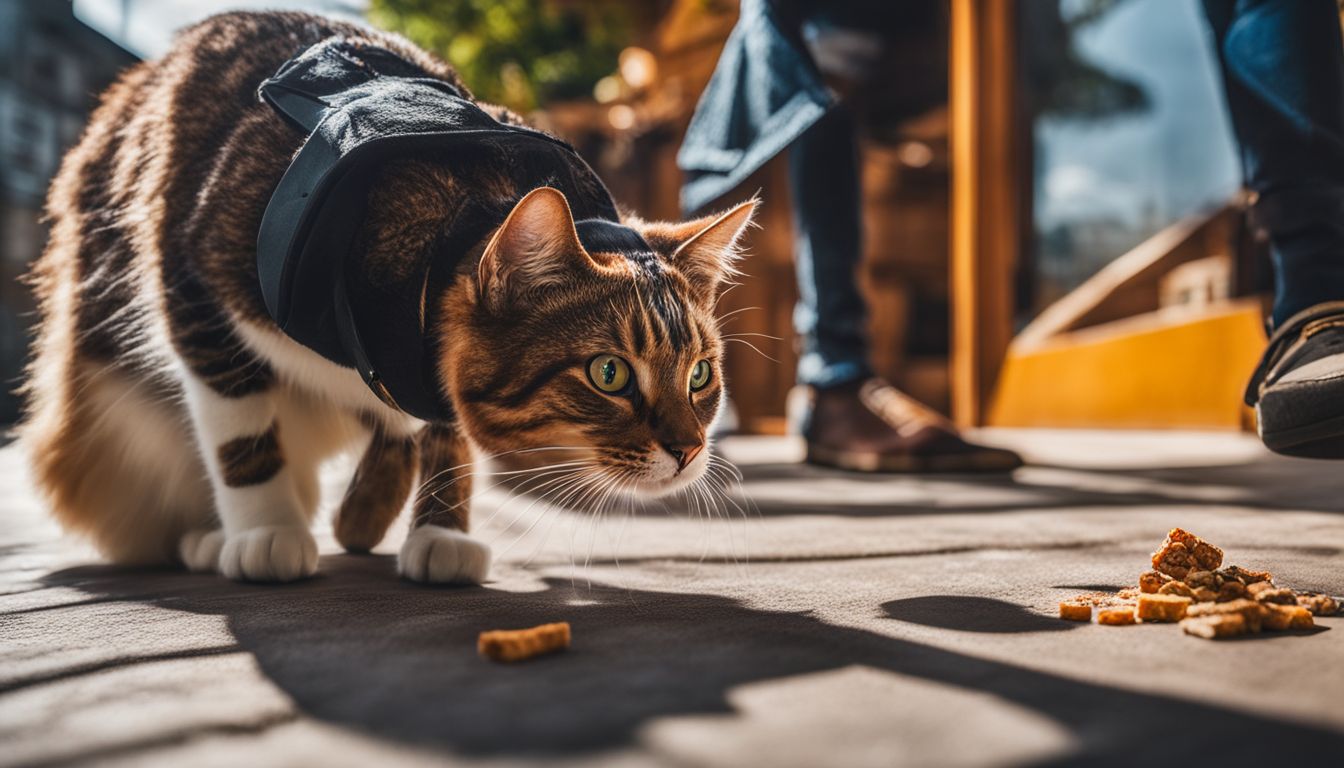You’ve just added an adorable feline friend to your family, but it feels like they’re holding back a bit – not exactly the warm welcome you might have hoped for. No worries though, you’re not alone in this kitty conundrum.
According to our friends at the American Veterinary Medical Association, our cat companions are notoriously good at keeping their emotions under wraps – making them one tricky puzzle to solve! Fear not- This blog post will serve as your all-in-one guide packed with expert advice and tips on how to gain your new pet’s trust and build a strong, loving bond.
Ready for some tried-and-true cat whispering secrets? Let’s dive right in!
Key Takeaways
- Cats communicate through body language, so it’s important to understand their signs of comfort and discomfort before approaching them.
- To gain a cat’s trust, be calm, and slow, and let the cat approach you on its own terms. Provide treats as positive reinforcement.
- Respect a cat’s boundaries and preferences by observing their likes and dislikes. Mimic their body language to help them feel more comfortable around you.
- Create a cat-friendly environment with cozy hiding spots, fresh water, scratching posts, interactive toys, and perches or shelves for climbing.
Contents
Understanding a Cat’s Behavior

Cats communicate through their body language, and it’s important to understand the signs of comfort or discomfort before approaching them.
Signs of comfort
A happy cat often purrs and relaxes their tail. They have half-closed eyes and soften their gaze. Ears point forward, not back or to the side. This shows they feel safe with you. A slow blink from a cat is like a hug in human terms! If your feline friend does this, it’s a good sign of comfort.
Also wagging the end part of their tail while it’s pointed up means they’re quite pleased to see you!
Signs of discomfort
Cats show they are not at ease in many ways. They may hide or try to run away. Their eyes might get wide and their tails may puff up too. Ears back and low hisses are also signs of worry.
You’ll see them lick their lips a lot if they’re scared. They could also have a hard time sitting still. Watch for these signs so you can help your cat feel better fast.
How to approach a cat
Be calm and slow when you move near a cat. Loud sounds or fast moves scare them. Sit down close by, but don’t stare at the cat. Cats see this as scary too. Put your arm on the floor away from your body with some tasty treats scattered near it.
Now comes the waiting game. Let the cat decide to come to you. If it doesn’t, try again later or another day with more treats. Once they feel safe and relaxed around you, they will trust you more.
What Makes Cats Mad

Cats can become aggressive when they feel threatened or provoked, so it’s important to understand their boundaries and triggers for anger.
Aggressive behavior
Cats can sometimes display aggressive behavior, which can include hissing, swatting, or scratching. They may act this way if they feel threatened or afraid. It’s important to understand that aggression is their way of communicating and protecting themselves.
To prevent aggressive behavior, it’s crucial to identify what triggers your cat’s anger and how to avoid those situations. Respecting their boundaries and providing a calm environment helps in managing aggression.
Remember, building trust with your cat is essential for reducing aggressive behavior and creating a harmonious relationship.
Triggers for anger
Cats can get angry for various reasons. Here are some things that can trigger their anger:
- Loud noises
- Sudden movements
- Being petted in a way they don’t like
- Feeling threatened or cornered
- Pain or discomfort
- Changes in their environment or routine
- Interactions with other pets
Understanding a cat’s boundaries
Cats are creatures that value their personal space and boundaries. It’s important to respect their need for distance and not invade their space without permission. If a cat is uncomfortable or feels threatened, they may display signs of discomfort such as hissing, growling, or swatting.
To approach a cat in a more comfortable way, it’s best to let them come to you on their own terms rather than forcing interaction upon them. Pay attention to their body language and give them the option to initiate contact when they feel ready.
By understanding and respecting a cat’s boundaries, you can build trust and create a positive bond with your feline friend.
9 Tips for Getting a Cat to Like You

Here are 9 expert tips that will help you build trust and bonding with your feline friend. From letting the cat approach you to playing with them regularly, these tips will surely make your cat like you more! Read on to learn more.
Let the cat approach you
Allowing the cat to approach you is an important step in building trust and bonding with them. Instead of going towards the cat, give them space and time to come to you on their own terms.
Avoid forcing contact or overwhelming them with attention. By letting the cat take the lead, they will feel more comfortable and in control, which can help establish a positive connection between you both.
Patience is key when it comes to earning a cat’s trust, so allow them to come closer at their own pace.
Allowing the cat to initiate contact
When building a bond with a cat, it’s important to let them take the lead and initiate contact. This shows respect for their boundaries and allows them to feel comfortable and in control.
Instead of approaching the cat directly, give them space and wait for them to come to you on their own terms. You can create an inviting environment by sitting or lying down on the floor, as this makes you less intimidating.
Avoid making sudden movements or loud noises that might scare the cat away. By allowing the cat to initiate contact, you are giving them the opportunity to build trust at their own pace, leading to a stronger bond between you both.
Observing their likes and dislikes

To build a bond with your cat, it’s important to observe their likes and dislikes. Watch how they react to certain things and pay attention to their body language. This will give you clues about what makes them comfortable or uncomfortable.
For example, if your cat enjoys being petted on the head but reacts negatively when touched on the belly, avoid touching their belly in the future. By observing their preferences and respecting their boundaries, you can create a positive and trusting relationship with your feline friend.
Mimicking their body language
To build trust and bond with a cat, it’s important to pay attention to their body language. Cats communicate through subtle cues, so mimicking their body language can help them feel more comfortable around you.
If they are relaxed and happy, try mirroring their posture by sitting or lying in a similar way. Avoid making sudden movements or invading their personal space if they seem tense or scared.
By observing and responding to their body language, you can create a sense of understanding and connection with your feline friend.
Creating a cat-friendly environment
To create a cat-friendly environment, it’s important to consider their needs and preferences. Provide them with a space where they feel safe and comfortable. Set up cozy hiding spots like boxes or blankets for them to retreat to.
Make sure they have access to fresh water and multiple litter boxes in quiet areas. Give them scratching posts or pads for their natural instinct to scratch. Provide interactive toys that stimulate their senses and encourage playtime.
Create perches or shelves at different heights for them to climb and observe their surroundings. Overall, make sure your home is a calm and peaceful place where your cat can relax and feel at ease.
Use treats strategically
To build trust and bond with a cat, it’s important to use treats strategically. By offering tasty treats as positive reinforcement, you can show the cat that good things happen when they are around you.
You can start by placing a treat on the floor near you and letting the cat come to you at their own pace. This allows them to associate your presence with something enjoyable. Another technique is scattering treats in their environment while they are exploring or playing, which helps create positive associations with being close to you.
Remember to be patient and consistent in using treats as rewards, and soon enough, your cat will begin to see you as someone they can trust and enjoy being around.
Be playful but know when to stop
Playing with your cat is a great way to bond and build trust. It shows them that you’re fun and enjoyable to be around. But it’s important to know when to stop. Pay attention to your cat’s body language and cues.
If they start becoming agitated or seem disinterested, it’s time to give them some space. Don’t push them too far or force them into playing if they don’t want to. Respect their boundaries and let them take breaks when needed.
Remember, playtime should always be positive and enjoyable for both you and your cat!
Playing with them regularly
Playing with your cat regularly is a great way to build trust and strengthen your bond. Interactive play sessions not only provide physical exercise but also mental stimulation for your feline friend.
Use toys that mimic natural prey, like feather wands or laser pointers, to engage their hunting instincts. Make sure to schedule regular playtime each day, keeping the sessions short and fun-filled.
Remember to let your cat take breaks when they need it and never force them to play if they’re not in the mood. By playing together regularly, you’ll create positive experiences and show your cat that you’re a source of joy and entertainment in their life.
Socializing them when young
Socializing cats when they are young is crucial for their social development. It helps them become comfortable around people, other animals, and new environments. One way to socialize a young cat is by introducing them to different people and places gradually.
Start with familiar faces and then slowly expose them to new ones. Similarly, introduce them to other pets in a controlled and supervised manner. This will help them feel more at ease with other animals in the future.
By providing positive experiences during their early years, you can help your cat grow into a well-adjusted and sociable companion.
Socialization Tips for Young Cats

When socializing young cats, it’s important to gradually introduce them to new people and environments while providing a safe and positive experience.
Introducing them to new people and environments
When it comes to introducing cats to new people and environments, it’s important to take things slow. Cats can be easily overwhelmed, so giving them time and space is crucial. Start by allowing the cat to explore their surroundings at their own pace.
Make sure they have a safe hiding spot where they can retreat if they feel nervous. When introducing them to new people, let the cat approach on their terms. Avoid forcing interactions or overwhelming them with attention.
Offer treats as positive reinforcement when the cat shows curiosity or interest in new experiences. Remember that patience and respect for the cat’s boundaries are key in helping them adjust and feel comfortable in unfamiliar situations.
Slowly introducing them to other pets
When introducing a cat to other pets, it’s important to take things slow. Start by allowing them to sniff each other’s scents without direct contact. Gradually increase their interactions under supervised circumstances to ensure they feel safe and comfortable.
Pay attention to their body language and intervene if any signs of fear or aggression arise. Providing separate spaces for each pet initially can also help ease the transition. Remember, patience is key when introducing cats to other animals, as it may take time for them to establish a positive relationship.
Understanding If a Cat Likes You

When it comes to understanding if a cat likes you, there are some clear signs to look out for. One of the most common ways cats show affection is through their body language. If your cat approaches you with a relaxed posture, gently rubbing against your legs or purring softly, these are all positive signs that they like you.
Additionally, if your cat makes eye contact with you and slowly blinks, it’s their way of showing trust and contentment.
On the other hand, if your cat avoids eye contact, keeps its distance from you or hides away when you’re around, it may be a sign that they feel uncomfortable or scared. It’s important to give them space and not force interactions when they’re not ready.
By respecting their boundaries and allowing them to approach you on their own terms, you can help build trust and strengthen your bond with your feline friend.
Understanding if a cat likes you requires patience and observation. Pay attention to how they react to your presence and respond accordingly. Each cat is unique and may have different ways of expressing their feelings towards humans.
By being attentive to their behaviors and providing them with love, care, and respect, you can develop a strong connection with your furry companion.
Conclusion

In conclusion, gaining a cat’s trust and building a bond takes time and patience. By respecting their boundaries, observing their body language, and using positive reinforcement through treats and playtime, you can develop a strong connection with your feline companion.
Remember to let the cat come to you on its own terms and create a cat-friendly environment for them to feel comfortable in. With these expert tips, you’ll be well on your way to earning your cat’s love and trust.
FAQs
1. How can I build trust and bond with a cat?
Building trust and bonding with a cat can be done by giving them space, using gentle behavior, providing treats and toys, and engaging in interactive play.
2. What should I do if a cat doesn’t seem to like me?
If a cat doesn’t seem to like you, give them time and space to adjust. Offer treats or toys as positive reinforcement and try engaging in activities they enjoy, such as play or grooming.
3. Can I force a cat to like me?
No, you cannot force a cat to like you. Building trust takes time and patience; it’s important to respect the boundaries of each individual cat.
4. How long does it typically take for a cat to warm up to someone new?
The time it takes for a cat to warm up to someone new varies depending on the individual cats’ personality and past experiences. It could take days, weeks, or even months.
5. What are some signs that indicate a cat is starting to like me?
Signs that indicate a growing connection with a cat include purring when around you, seeking physical contact (such as rubbing against you), playing together, or grooming themselves when relaxed in your presence.

